B-1
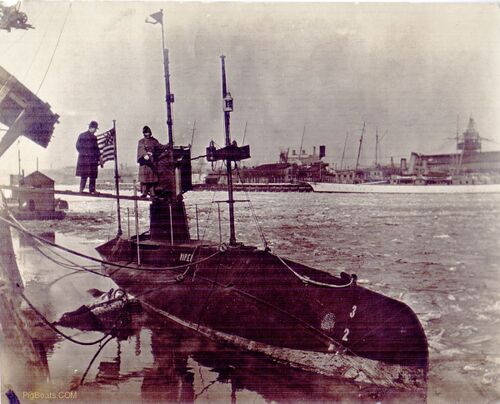
We think that the photo was taken at or near the Brooklyn (New York) Navy Yard just prior to a dry dock period that all three B-boats had in January, 1908. If it was after dry docking the waterline would appear cleaner and crisper.
The submarine has the paint scheme given to the vessels around the time of their commissioning with darker colors, (black), and a light, (white), boot-top. On the foremast are the submarine's red and green running lights attached to their reflector boards. These boards are to limit the direction that the lights can be seen from. Above them, the anchor light is higher on the mast. This is a white light and used when at anchor to note it position to other vessels. All these lights and the mast are portable and are removed and sent below when the submarine is going to dive. Stanchions and a lifeline surround the small walking deck that submarine inventor John Holland so detested, ("...for officers to strut on...", he said). These, too, were sent below when diving.
Photo in the private collection of Ric Hedman

The top of the bridge is surrounded by weather canvas to protect the crew, (duty officer and helmsman), from spray and wind. Just forward of the canvas is a ventilator used to bring or exhaust air from inside the submarine. Its opening is pointing to the sub's port side. These, along with all the above mentioned items, are also sent below before diving. Pressure of moving though the water would restrict the vessels movements, reduce its speed and probably destroy canvases.
There appears to be a fairly stiff wind blowing by the looks of all the flags and that wind seems to be coming from the subs after port quarter. The flag is a thirteen-star Naval Ensign. As related by flag historian Jeff Bridgman..."It wasn't until 1916, however, that President Woodrow Wilson wrote an executive order that terminated their use entirely in favor of 48-star flags. But even this did not completely put an end to it. According to at least one flag historian, Wilson's order was not immediately accepted on all navy ships. Old habits die hard..." The flag being flown seems to be of an older design that was flown between 1890 and 1900 with the rows of 3 stars with points pointing up and the rows with two stars with the points pointing down. The wind chill factor must make the temperatures must feel like they are in the upper 20's down into the teens or lower.
National Archives photo
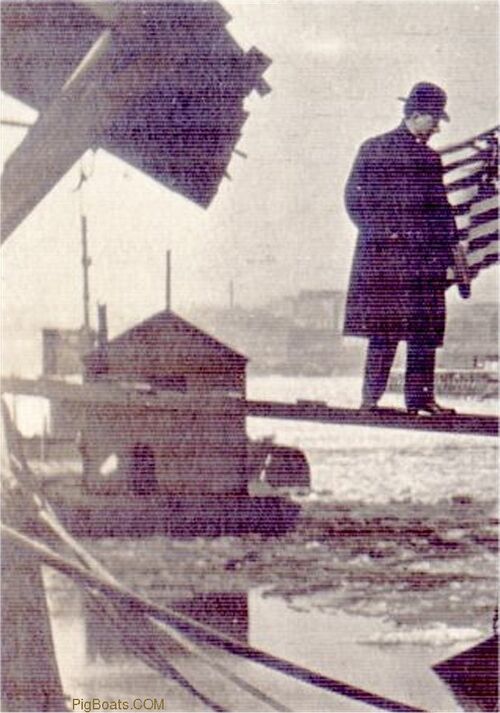
National Archives photo
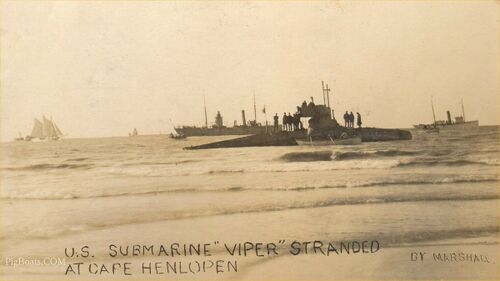
The image shows the Viper, laying aground with the gunboat USS Castine (Gunboat No. 6) and the Delaware Breakwater behind her. Cape Henlopen is at the mouth of the Delaware River and just across from Cape May, New Jersey where the Navy use to have a submarine support facility.
The day before, October 23, 1909, the Castine, the Tarantula (Submarine No. 12), the Viper (Submarine No. 10), the Cuttlefish (Submarine No. 11) and the Plunger (Submarine No. 2) had left from Tompkinsville on Staten Island, NY for Charleston, SC.
As best as can be deduced from the newspaper accounts the submarines Viper, Cuttlefish, and Plunger along with their tender Castine, had come to anchor for the night in the shelter of Cape Henlopen and the Delaware Breakwater. During the night Viper's anchor had dragged and the submarine had gone aground. The Cape is actually off camera to the right.
Just above the after deck of the Castine, behind the submarine, can be seen the breakwater's East End Lighthouse, looking like a part of Castine's superstructure. To the left and aft of the Castine is the rest of the breakwater, as it was built in 1909, and can be seen with the breakwater's West End Lighthouse in place. Today the breakwater has been extended and this lighthouse is gone. The ship on the right is not identified.
The Paterson Morning Call, Tuesday, October 26, 1909:
"Philadelphia, Oct. 25 . ~ The United States submarine Viper is aground inside Cape Henlopen, near the Delaware Breakwater. The boat is reported to be resting easy, but her position is dangerous and there are fears for her safety."
"The life saving crew from Lewes, Del., is standing by and making every effort to drag the vessel off the shoal."
Photo in the private collection of Ric Hedman
Thanks to the United States Lighthouse Society for identification assistance.

Viper underway in the East River off New York City in 1909. Her crew has erected a pipe frame and canvas bridge structure to help protect the bridge watchstanders.
NARA photo 19-N-13457, a copy in the private collection of Ric Hedman.
USS Viper (Submarine No. 10) crew muster for April 15, 1910. Data is incomplete due to lost records. All listed below are enlisted sailors, rank and rate unknown.
| Rall, W. F. - age 27- Born: New York |
| Sylvester, H. - age 26 - Born: Oregon |
| Kirkhacket, R. W. - age 25 - Born: Illinois |
| Johnston, F. A. - age 21 - Born: Pennsylvania |
| Barto, D. B. - age 28 - Born: Delaware |
| Regan, J. A. - age 24 - Born: Ohio |
| Doom, R. W. - age 36 - Born: Ohio |
| Poncet, J. L. - age 20 - Born: Louisiana |
| Noltny, C. F. - age 30 - Born: Missouri |
| Cole, C. D. - age 30 - Born: Massachusetts |
| Romulus, G. J. - age 34 - Born: Massachusetts |
| Boyan, J. - age 26 - Born: New Jersey |
Thank you to Linda Talbott of the US GenWeb Census Project® for providing this information.

This photo is taken mid-April 1915 in Cavite Harbor, Philippines. It shows the USS Hector (Collier No. 7) with an unusual deck cargo. The Hector had left the U.S. in March 1915 with the submarines A-5 (closest to camera), A-3 (in the middle), and the B-1 (behind) as deck cargo for transport to the Philippines since the craft were too small to make the trip on their own. Note that the B-1 has both its periscopes still installed where the "A" boats had been removed for transit. In preparation for the trip the batteries had been removed as well as the propellers and the stern planes; all to lighten the weight of these vessels for transport as deck cargo.
The view in this photo is from the port side of the Hector. Launching skids have been constructed for launching the submarines over both sides. Hector's bow is to the left in this photo.
U.S. Navy photo.
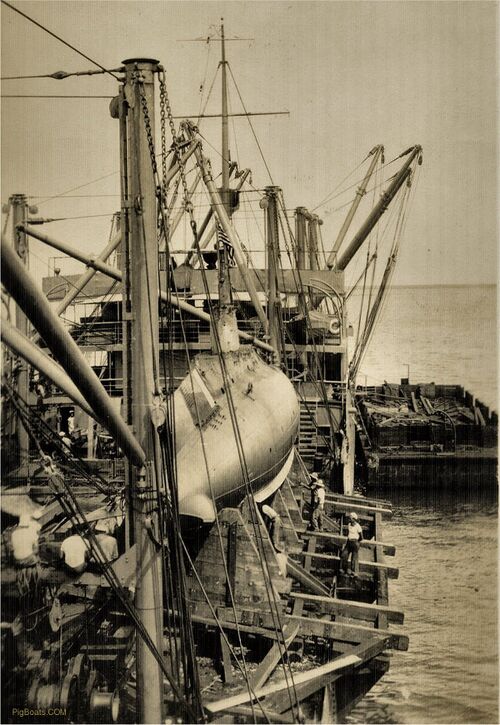
A view from aft on the collier Hector as the crew prepares to launch the B-1 over the starboard side, April 15, 1915. The wood skids would be greased up and once the launch key was removed the boat would slide down the skids in its cradle, dropping into the water once the cradle reached the end of the skids. In this view you are looking at the B-1's stern.
In this photo it is quite clear that this larger submarine needed three launch ramps compared to the two used by the smaller A-boats. Those smaller submarines have already been launched as the deck to the left in the photo is empty.
Several other things to notice are the lack of rudders, stern planes, and the propeller. These items were removed to make the submarine lighter to transport and also to prevent damage to them during the launch, which consisted of literally throwing them off the ship into the water.
There is an assortment of personnel seen working on the vessel. The men in broad hats are probably Filipino contractors, where as the sailors pretty much look like sailors. At the top of the submarines periscopes is a large American Flag.
Photo in the private collection of Ric Hedman
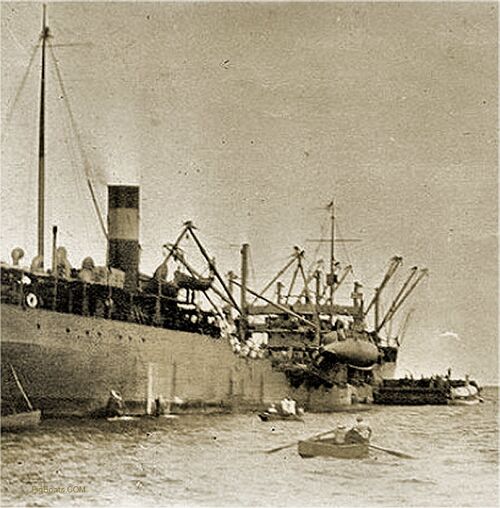
April 15, 1915, USS B-1 goes over the side with a large crowd of Navy and Filipinos watching. The ramps have been tipped up and the little submarine becomes airborne, one of the very few times a submarine will ever "fly".
The view is of the starboard side of the collier USS Hector, and the view is looking forward. At the top of the periscopes the American flag is now flying out stiffly horizontal to the left in the photo showing the speed in which the craft is moving.
U.S. Navy photo.
Page created by:
Ric Hedman & David Johnston
1999 - 2023 - PigBoats.COM©
Mountlake Terrace, WA, Norfolk, VA
webmaster at pigboats dot com
